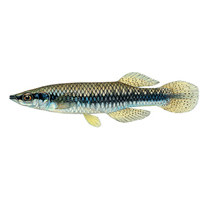Blackstripe topminnow
Scientific name: Fundulus notatus

Cover photo credit: Joseph R. Tomelleri
Status
Special Concern
“Special Concern” means the species lives in the wild in Ontario, is not endangered or threatened, but may become threatened or endangered due to a combination of biological characteristics and identified threats.
Date added to the Species at Risk in Ontario List
February 18, 2009.
Read the assessment report.
What it looks like
The Blackstripe Topminnow is a small member of the Killifish family, and normally grows to about five to seven centimetres long. It has a streamlined shape for fast swimming and an upturned mouth which help in ambushing adult insects which are taken from the water’s surface. Males have a black horizontal band with vertical bars on their sides and yellowish fins, whereas females lack the vertical bars and have slightly paler fins.
Where it lives
This species prefers slow-flowing streams which have abundant plant cover within the stream. In addition, a key part of the species habitat is an abundance of vegetation on the stream banks. These vegetated areas are important habitats as they provide areas where the species can hide from predators and where they can find food.
Where it’s been found in Ontario
The Blackstripe Topminnow occurs in the south-central United States, ranging from the Gulf states north to the lower Great Lakes. In Canada, this species occurs only in the Sydenham River and associated creeks in southwestern Ontario.
View a larger version of this map (PDF)
What threatens it
Blackstripe Topminnows rely on healthy plant life within the stream and along its banks as a source of cover and food supply. Activities that remove or alter this vegetation, including access to the rivers and trampling of banks by livestock and shoreline modifications pose a threat to the survival of Blackstripe Topminnow. Additional threats may include channelization of watercourses and drainage of wetlands and removal of water for irrigation, all of which may alter the natural flows in the streams and creeks where they live, making the species more susceptible to low-flow conditions. Other potential threats include oil seepage from oil wells, sedimentation, nutrient loading, exotic species and agricultural pesticides.
Action we are taking
Special concern species do not receive species or habitat protection.
What you can do
Report a sighting
- Report a sighting of an endangered animal or plant to the Natural Heritage Information Centre. Photographs with specific locations or mapping coordinates are always helpful.
Volunteer
- Volunteer with your local nature club or provincial park to participate in surveys or stewardship work focused on species at risk.
Be a good steward
- Private land owners have a very important role to play in species recovery. You may be eligible for stewardship programs that support the protection and recovery of species at risk and their habitats.
- Land owners can help improve fish habitat and keep Ontario’s water safe and clean by maintaining natural vegetation next to creeks and rivers, and keeping pollution and soil from washing into Ontario’s rivers. You can find more information about programs and funding assistance for eligible farmers from the Ontario Soil and Crop Improvement Association website at www.ontariosoilcrop.org/en/programs/species_at_risk.htm.
Report illegal activity
- Report any illegal activity related to plants and wildlife to
1-877-TIP-SMNR (847-7667) .
Quick facts
- The Blackstripe Topminnow was first discovered in Ontario in 1972, however it is believed that it has always lived here and has always been very rare.
- Male Blackstripe Topminnows tend to have larger dorsal and anal fins then the females.
- Blackstripe Topminnows are only found in a very small area of Ontario and may have one of the smallest distributions of any fish in Canada.
- Blackstripe Topminnows live for two to three years. In the summer, they tend to stay within a few centimetres of the surface of the water. In the winter, they retreat to deeper water.
- The Blackstripe Topminnow is one of very few fish species in Canada that feed primarily on terrestrial insects (the Redside Dace, considered to be Endangered, is another).
- In the summer, females lay 20-30 eggs which the male attaches individually to aquatic plants.
